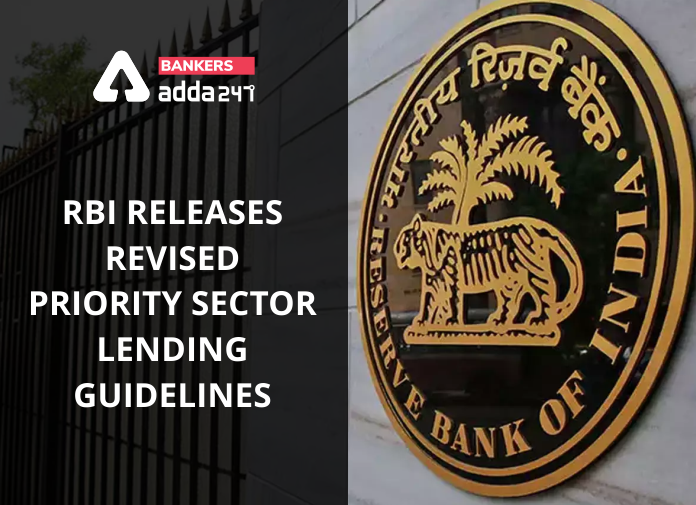Reserve Bank of India has issued revised guidelines related to Priority Sector Lending (PSL) to align it with emerging national priorities and bring a sharper focus on inclusive development, after having wide-ranging discussions with all stakeholders.
![]()
Revised PSL guidelines will enable better credit penetration to credit deficient areas, increase the lending to small and marginal farmers and weaker sections, boost credit to renewable energy, and health infrastructure.
Bank finance to start-ups (up to ₹50 crore), loans to farmers for installation of solar power plants for solarisation of grid connected agriculture pumps and loans for setting up Compressed Bio Gas (CBG) plants have been included as fresh categories eligible for finance under priority sector.
Some of the salient features of revised PSL guidelines are:
- To address regional disparities in the flow of priority sector credit, higher weightage have been assigned to incremental priority sector credit in ‘identified districts’ where priority sector credit flow is comparatively low.
- The targets prescribed for “small and marginal farmers” and “weaker sections” are being increased in a phased manner.
- Higher credit limit has been specified for Farmers Producers Organisations (FPOs)/Farmers Producers Companies (FPCs) undertaking farming with assured marketing of their produce at a pre-determined price.
- Loan limits for renewable energy have been increased (doubled).
- For improvement of health infrastructure, credit limit for health infrastructure (including those under ‘Ayushman Bharat’) has been doubled.
Also Check
- Centre constitutes National Council for Transgender Persons
- World Photography Day 2020: Read to know more
- World Elephant Day celebrated on 12th August
What Sectors come under Priority Sector lending?
The RBI has Eight identified sectors for priority lending, which include:
1. Agriculture:
The lending to agriculture sector will include Farm Credit (Agriculture and Allied Activities), lending for Agriculture Infrastructure and Ancillary Activities.
- Farm Credit – Individual farmers
- Farm Credit – Corporate farmers, Farmer Producer Organisations Companies of Individual Farmers, Partnership firms and Co-operatives of farmers engaged in Agriculture and Allied Activities
- Agriculture Infrastructure
- Ancillary Services
- Small and Marginal Farmers (SMFs)
- Lending by banks to NBFCs and MFIs for on-lending in agriculture
2. Micro, Small and Medium Enterprises:
- Factoring Transactions (not applicable to RRBs and UCBs)
- Khadi and Village Industries Sector (KVI)
- Other Finance to MSMEs
3. Export Credit:
Export credit under agriculture and MSME sectors are allowed to be classified as PSL in the respective categories viz. agriculture and MSME. Export credit includes pre-shipment and post-shipment export credit (excluding off-balance sheet items) as defined in Master Circular on Rupee / Foreign Currency Export Credit and Customer Service to Exporters issued by Department of Regulation
4. Education:
Loans to individuals for educational purposes, including vocational courses, notexceeding Rs 20 lakh will be considered as eligible for priority sector classification. Loans currently classified as priority sector will continue till maturity.
5. Housing:
- Loans to individuals up to Rs 35 lakh in metropolitan centres (with population of ten lakh and above) and up to Rs 25 lakh in other centres for purchase/construction of a dwelling unit per family provided the overall cost of the dwelling unit in the metropolitan centre and at other centres does not exceed ₹45 lakh and ₹30 lakh respectively. Existing individual housing loans of UCBs presently classified under PSL will continue as PSL till maturity or repayment.
- Housing loans to banks’ own employees will not be eligible for classification under the priority sector.
- Since Housing loans which are backed by long term bonds are exempted from ANBC, banks should not classify such loans under priority sector. Investments made by UCBs in bonds issued by NHB / HUDCO on or after April 1, 2007 shall not be eligible for classification under priority sector.
- Loans up to Rs 10 lakh in metropolitan centres and up to Rs 6 lakh in other centres for repairs to damaged dwelling units conforming to the overall cost of the dwelling unit.
- Bank loans to any governmental agency for construction of dwelling units or for slum clearance and rehabilitation of slum dwellers subject to dwelling units with carpet area of not more than 60 sq.m.
- Bank loans for affordable housing projects using at least 50% of FAR/FSI for dwelling units with carpet area of not more than 60 sq.m.
- Bank loans to HFCs (approved by NHB for their refinance) for on-lending,up to Rs 20 lakh for individual borrowers, for purchase/construction/reconstruction of individual dwelling units or for slum clearance and rehabilitation of slum dwellers.
- Outstanding deposits with NHB on account of priority sector shortfall.
6. Social Infrastructure:
Bank loans to social infrastructure sector as per limits prescribed below are eligible for priority sector classification:
- Bank loans up to a limit of Rs 5 crore per borrower for setting up schools, drinking water facilities and sanitation facilities including construction/ refurbishment of household toilets and water improvements at household level, etc. and loans up to a limit of Rs 10 crore per borrower for building health care facilities including under ‘Ayushman Bharat’ in Tier II to Tier VI centres. In case of UCBs, the above limits are applicable only in centres having a population of less than one lakh.
- Bank loans to MFIs extended for on-lending to individuals and also to members of SHGs/JLGs for water and sanitation facilities subject to thecriteria laid down in paragraph 21 of these Master Directions. # not applicable to RRBs, UCBs and SFBs.
7. Renewable Energy and Weaker Sections:
Bank loans up to a limit of Rs 30 crore to borrowers for purposes like solar based power generators, biomass-based power generators, wind mills, micro-hydel plants and for non-conventional energy based public utilities, viz., street lighting systems and remote village electrification etc., will be eligible for Priority Sector classification. For individual households, the loan limit will be Rs 10 lakh per borrower.
8. Others:
The central bank has in its eight category of ‘Others’ included lending to Self Help Groups (SHG), distressed persons and State Sponsored Organisations for Scheduled Castes/ Scheduled Tribes. The following loans as per the prescribed limits are eligible for priority sector classification:
- Loans not exceeding Rs 1.00 lakh per borrower provided directly by banks to individuals and individual members of SHG/JLG, provided the individual borrower’s household annual income in rural areas does not exceed Rs 1.00 lakh and for non-rural areas it does not exceed Rs 1.60 lakh, and loans not exceeding Rs 2.00 lakh provided directly by banks to SHG/JLG for activities other than agriculture or MSME, viz., loans for meeting social needs, construction or repair of house, construction of toilets or any viable common activity started by the SHGs.
- Loans to distressed persons [other than distressed farmers indebted to noninstitutional lenders] not exceeding Rs 1.00 lakh per borrower to prepay theirdebt to non-institutional lenders.
- Loans sanctioned to State Sponsored Organisations for Scheduled Castes/Scheduled Tribes for the specific purpose of purchase and supply of inputs and/or the marketing of the outputs of the beneficiaries of these organisations.
- Loans up to Rs 50 crore to Start-ups, as per definition of Ministry of Commerce and Industry, Govt. of India that are engaged in activities other than Agriculture or MSME.
Also Check
Click Here to Register for Bank Exams 2020 Preparation Material
Visit Achieversadda.com and participate in discussions with other aspirants and achievers. Get answers to your queries and connect with others on Achieversadda.com




 Adda247 Launched the Coaching with Degre...
Adda247 Launched the Coaching with Degre...
 Financial Regulators In India
Financial Regulators In India
 What is the Monthly Salary of Bank PO?
What is the Monthly Salary of Bank PO?


